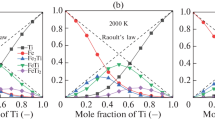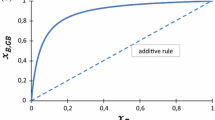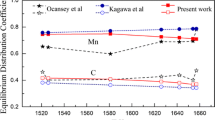Abstract
As nonmetals are added to the Fe-Ni system, segregation coefficients(k) of trace constituents change dramatically. For example, as the S content of the metallic liquid increases from 0 to ≈31 wt pct, the molar k(Ge) between solid and liquid metal increases from 0.6 to ~120. Little of this change can be ascribed to temperature. Also, these changes are not linear. In the case of the Fe-Ni-S system, the largest changes are seen between 20 and 30 wt pct S. Here we present a model for the interaction of nonmetals with other species in metallic systems. The model assumes that the nonmetal either repels or attracts tracers (E) in the metallic liquid, causing those tracers to either segregate strongly into the solid metal or to have enhanced solubility in the liquid. Examples of both types of behavior are given. The model predicts that the activity coefficient of the tracer (γE) should correlate linearly with (1 - αnXN @#@), where XN is the mole fraction of the nonmetal in the metallic liquid,n is a stoichiometry factor related to the speciation of N in the liquid, and a is a constant. Indeed, good linear correlations of n(k) vs n (1 -αnXN @#@) are found for all elements where there is a measurable effect. Thus, if the composition of the metallic liquid is known, a segregation coefficient of a trace constituent may be pre-dicted— even if the temperature, exact Fe/Ni ratio, and information about the activity coef-ficient in the solid phase are unknown. The nonmetal interaction model presented here can be related to more traditional methods of modeling activity coefficients(i.e., power law expan-sions) and can be shown to be a special case of this type of parameterization. Comparison of model predictions of first-order (sulfur-E) interaction coefficients (ε) to measured values yields acceptable agreement for some elements, such as P and Ge, and all elements except Ni agree to within a factor of 3. The predictive model described above, based on equilibrium experi-ments, may be used to evaluate the segregation coefficients extracted from the dynamic (“plane front solidification”) experiments of Sellamuthu and Goldstein.[10,11] Contrary to claims, reliable segregation coefficients are not extractable from dynamic experiments.
Similar content being viewed by others

References
J. Willis and J.I. Goldstein:J. Geophys. Res. Suppl., Nov. 1982, vol. 87, pp. A435–45.
C. Narayan and J.I. Goldstein:Metall. Trans. A, 1981, vol. 12A, pp. 1883–90.
J.H. Jones and M.J. Drake:Geochim. Cosmochim. Acta, 1983, vol. 47, pp. 1199–1209.
C.H.P. Lupis:Chemical Thermodynamics of Materials, North- Holland, Amsterdam, The Netherlands, 1983, 581 pp.
R.C. Sharma and Y.A. Chang:Metall. Trans. B, 1979, vol. 10B, pp. 103–08.
G.K. Sigworth and J.F. Elliott:Met. Sci., 1978, vol. 8, pp. 298–310.
D.J. Malvin, J.H. Jones, and M.J. Drake:Geochim. Cosmochim. Acta, 1986, vol. 50, pp. 1221–31.
R.W. Bild and M.J. Drake:Proc. 9th Lunar and Planet Sci. Conf., Pergamon, New York, NY, 1978, pp. 1407–21.
C. Narayan and J.I. Goldstein:Geochim. Cosmochim. Acta, 1982, vol. 46, pp. 259–68.
R. Sellamuthu and J.I. Goldstein:Metall. Trans. A, 1984, vol. 15A, pp. 1677–85.
R. Sellamuthu and J.I. Goldstein:Metall. Trans. A, 1985, vol. 16A, pp. 1871–78.
R. Sellamuthu and A.F. Giamei:Metall. Trans. A, 1986, vol. 17A, pp. 419–28.
Author information
Authors and Affiliations
Rights and permissions
About this article
Cite this article
Jones, J.H., Malvin, D.J. A nonmetal interaction model for the segregation of trace metals during solidification of Fe-Ni-S, Fe-Ni-P, and Fe-Ni-S-P alloys. Metall Trans B 21, 697–706 (1990). https://doi.org/10.1007/BF02654248
Received:
Issue Date:
DOI: https://doi.org/10.1007/BF02654248



